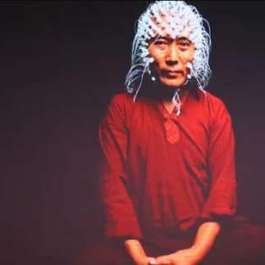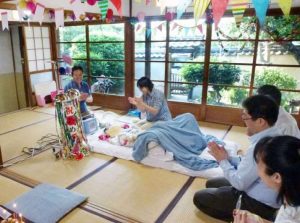This article provides an argument for the pragmatic value of a model intended to witness (to a degree) and study karma’s chain of cause and effect through Sa?s?ra’s cycles. The key component of this model is lying out and defending the validity of the analogy between the act of waking up each day and rebirth, hence making the sequence of our life’s waking days as a model representation of the chain of forms i.e. lifetimes which our stream consciousness flows through.
Before we venture into the Buddhist interpretation and its application to karma witnessing, let’s look at the crucial analogy in terms of everyday experiences, and some support from uncontroversial psychological theories. It is generally accepted and supported by overwhelming evidence from developmental psychology and numerous studies on children and their adult lives that the contingencies of our childhood greatly influence, if not outright determine, the rest of our lives. Now consider this. Let’s look at our morning as the “childhood” of our day-“lifetime”. Surely most of you, at some time experienced a frustrating or annoying event early in the morning which ruined the rest of your day. The converse also seems to be true – a good night’s sleep, some good news or a generous word from a stranger in the morning can put such a positive spin on our mood that the rest of the day seems to be equally wonderful, and we notice that everything works out just right. Is that a coincidence? I think not, as I believe that the waking day almost literally is a kind of novelized and self contained minature of the greater story we call life. It also has its womb gestation period (sleep and dreaming), birth (the act of waking), various rites of passage (our daily routines), and death (as we let go of consciousness temporarily and let it digest the contingencies of the day).
There’s more evidence to support this. We know that children, youth and adults tend to generally spend most time interacting within their age group (for obvious reasons). There are exceptions caused by child rearing and certain career choices, but let’s focus on general tendencies. Now consider this example. I had worked in the past in large studios, and often worked nights, which meant that after having spent the entire night working I would welcome my fellow workmen/women in the morning. What struck me was how the morning newcomers tended to mingle among each other (over the coffee and preparations to the start of the working day), as did the people who stayed overnight (reminiscing the experiences of the unusually long day) having shared a 24h+ waking day. Also, when interacting with the morning arrivees I noticed how our perception of any given moment differed (I would have the memories of the entire last 24h still fresh in my consciousness – forcing themselves to put everything in a broader context, where those who just woke up less than a couple of hours ago would be anticipating and planning the immediate tasks at hand) and how the choice of topics was to a degree less compatible. Isn’t that a striking parallel? The morning bunch was in their day “childhood”, whereas those who stayed up were in their day’s “senior years”. There is more evidence to support the strength of the waking day – life analogy, but for the purposes of this article the above should suffice.
The main motivation behind offering this analogy (model) intended to enhance the validity and immediacy of the karmic law, is the fact that in general we neither have memories of past lives nor immediate incentive to be constantly mindful of karmic law due to our cognitive limitations of seeing its consequences in future lives (although diligent study of the Buddha’s scriptures does lend a hand). Although this epistemic insight of all past and future lives may be accessible to Bodhisattva’s and Buddha’s, for most of us (who hopefully strive for enlightenment) this proposed model is the next best thing.
Let’s start with an example in order to give an intuitive feel for what I mean by, the witnessing of the karmic law in action over a number of lifetimes (days in our model). My intension is to be true to you folks so the example will be a personal one. Years ago shortly after almost seven years of a quite successful career, I entered a period of over a year of struggle and unemployment which trapped me and caused the development of a rather wretched mental state resembling depression. There seemed no way out – the notorious series of rejections from employees in that time seemed to deepen my suffering. At the same time I had noticed (I’m blessed with natural tendency of thought-emotion mindfulness – needless to say mindfulness is a necessary component of the ability to witness karma’s causal meanderings in the proposed model) that my thoughts often ventured toward quite negative and self destructive outlooks and perspectives. Those negative thought tendencies best fit the description of one of the ten nonvirtues – namely “wrong views”. How does one escape such a predicament? There may be a variety of ways depending on the subtle characteristics of the infliction. In my case I was blessed to have a moment of clarity – I realized that those negative periods of negative thinking were in themselves periods of suffering. The next thought was that whenever I reminisce over the past days, my mind will most likely come across the accumulated unpleasant memories of those periods of self destructive tendencies causing me (or certainly rising the risk) to experience at the moment of reminiscing something unpleasant – bringing an unpleasant memory to mind in itself is an unpleasant experience.
Do not think that the cultivation
Of even a tiny nonvirtue will not stay with you.
Just as a large vessel is filled
By drops of water falling,
So too is a fool filled with ill deeds
Accumulated a little at a time.
(The Buddha)
The only way to fix this was to stop thinking those negative thoughts at once(!), and thus cleanse my memory of unpleasant experiences. Soon after applying this karma cleansing balm, which wasn’t easy, my depression disappeared and I was pleasantly surprised to be offered a quite rewarding and fulfilling job opportunity. In the model I’m presenting here the interpretation of those events would be as follows: in some particular life (day) a change of attitude was implemented – namely abandoning one of the ten nonvirtues (“wrong views”) which are known to accumulate and have adverse consequences in accordance with karmic law. It still took a number of lives (weeks), of virtuous acts of avoidance of wrong views before came the day (life) where a substantial change could occur.
Do not think that the cultivation
Of even a tiny virtue will not stay with you.
Just as a large pot is filled
By drops of water descending,
So too are the resolute filled by virtues
Accumulated a little at a time.
(The Buddha)
Now let’s look at the properties of Karma and how they can be reinterpreted to fit the given model. Primarily it is the property of self determination and how it inevitably perpetuates as a chain of consequences resulting from preceding causes inflicted by any given individual.
Just as material things such as our bodies depend upon their own causes and conditions, so consciousness itself depends upon its respective causes and conditions[…]
(The Dalai Lama, Becoming Enlightened)
Consider the analogy of our home. Certain thoughtless tendencies could lead to allowing a mess creep into it; objects lying randomly scattered over the floor or obstructing the entrance, accumulated dishes that haven’t been washed etc. It’s not difficult to imagine tripping over a bag lying in the doorway as we enter the house in the evening, or some heavy pot falling on our foot as we make desperate attempts at finding a clean spoon among the messy kitchen top– certainly undesirable effects of our negligence. As an extreme example, imagine going to the toilet in the middle of our dining room(!) – certainly any guest that arrives for dinner will be less than impressed, to say the least! As for consciousness self determining its future states, the previous example with nourishing negative and self destructive thoughts provides a stark case in point.
We constantly self determine our, and our environment’s states on a daily basis. Messy house today – bruised knee tomorrow. What carries over from one day to the next, also applies to that which has been accumulated in one life and influencing the kind of rebirth we’ll have and future life may enter.
The tendency of habit acquisition and how those habits inadvertently determine our future lives can also be modeled nicely in the presented interpretation. In the same book the Dalai Lama writes:
[…]consciousness from the initial moment in the mother’s womb is affected by earlier predispositions, which means we need to consider that this initial moment may stem from the mental stream of a former lifetime.
Now if we interpret the previous day or days as former lifetimes and the period of slumber as analogous to the initial gestation period in the mother’s womb – the analogy fits perfectly. Studies have shown that the unconscious brain processes and internalizes all the experiences from the previous day – such a re-wiring supposedly strengthens the neural connections which reflect the recent behavioral, cognitive and experiential tendencies (supposedly intended to maximize the efficiency of our functioning in a given environment). And since certain compulsive behaviors and habits become inadvertently hard wired their previous manifestations enhance their dominance the next day (“life”).
To conclude, let’s just say that the above model attempts no more than providing a practical (and tangibly rewarding) approach to mindfulness of karmic phenomena. Its primary advantage is the ability to actually follow our karmic “engineering” projects, providing us with tangible results, and hence the incentive to be constantly mindful of the truth of this law.













